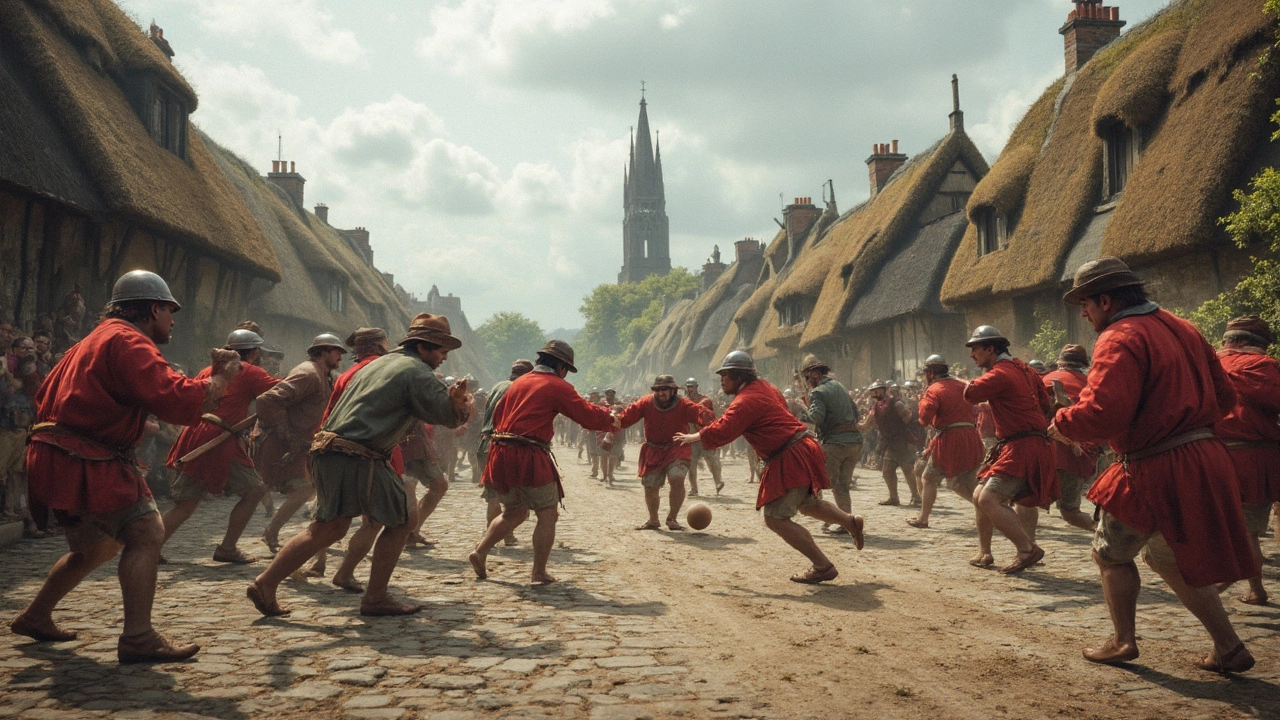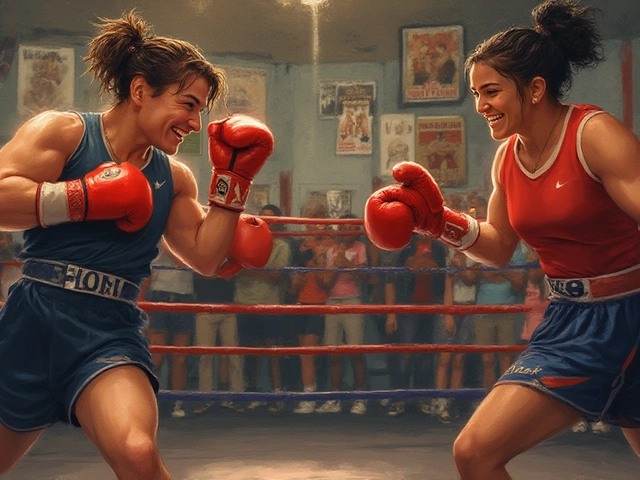Oldest Sport: Football’s Place in the History Books

If you think football is just a modern craze, think again. The urge to kick, throw, or chase a ball goes way back—so far that it’s nearly impossible to pin down the exact moment the oldest sport appeared.
People were playing ball games before most countries even had names. And when it comes to football, it turns out ancient folks loved it just as much—if not more—than the crowds do now. Imagine street matches that doubled as wild festivals or even led to riots. The roots of football are tangled up with weird rituals, rowdy celebrations, and some seriously funky rules.
Curious what these early matches actually looked like? Ever wonder how those chaotic games connect to Champions League drama? Stick around. There’s a lot about ancient football that might just blow your mind—and change how you watch a match this weekend.
- Digging Up Ancient Sports
- The Roots of Football
- Kicking Balls in Ancient Times
- Unusual Rules and Traditions
- How Modern Football Grew from Ancient Games
- Tips for Experiencing Ancient Football Today
Digging Up Ancient Sports
When people talk about the oldest sport, they usually imagine dusty relics or faded cave paintings. But the truth is, our ancient ancestors left behind way more than that. Archaeologists have actually found pretty clear proof that organized games go way back—thousands of years before anyone put on a jersey.
For example, digging in the ruins of ancient China, researchers uncovered records that date a ball-kicking game called "Cuju" to at least the 2nd century BCE. The Han dynasty loved it, and everyone from soldiers to royals got involved. The pitch was basically a dirt field, the goal was a cloth net, and the ball was, well, pretty rough compared to what we use now. Even so, most sports historians agree this is one of the closest early links to modern football.
But China wasn’t alone. Ancient Greeks had a rough-and-tumble game called “Episkyros,” which they played with teams, a ball, and… almost no rules. The Romans tweaked it and called their version “Harpastum.” It was especially popular with Roman soldiers and spread as far as the empire reached. These games weren’t just distractions—they were about skill, teamwork, and sometimes, staying alive on the field.
Across the globe, similar games popped up. In Mesoamerica (modern-day Mexico and Central America), people played a ball game called “Ōllamaliztli” over 3,000 years ago. While it wasn’t exactly football, it showed that ball games mattered everywhere humans settled, long before stadium lights and cheering crowds.
So what ties all these ancient sports together? They didn’t just pop up for fun. These games were a vital part of life—sometimes linked to military training, religious ceremonies, or fierce city rivalries. If people could kick or throw something, chances are, they turned it into a contest. It’s wild to think, but the basic idea at the heart of oldest sport—competition, skill, and a shared set of rules—has been around since before we kept written records.
The Roots of Football
When you think about football, you probably picture modern players, huge stadiums, and global tournaments. But the heart of football is way older than anything you’ll see on TV. Archaeologists in China found signs of a game called cuju dating back to 206 BC. Players kicked a leather ball filled with feathers through a small opening, and the rules sound surprisingly close to what we call football today—no hands, mainly feet.
Jump over to ancient Greece and Rome and you’ll find games like episkyros and harpastum. These were rough and chaotic, sometimes looking more like rugby than soccer, but the basic idea stayed—two teams, one ball, and a contest to control it.
In England, by the Middle Ages, towns and villages had annual football matches that could last all day. The ball wasn’t always round, and the “field” could stretch across miles with whole communities taking part. No goalie gloves or offside rules—people just gathered, kicked, and chased.
Why did football survive while other ball games faded away? It was easy to play—just a ball and open space. Everyone could join, no matter their background, and you didn’t need fancy gear to start. That’s a big part of why football grew to be the world’s most popular sport. People in different countries made their own tweaks, so you get everything from Italian calcio storico to Mesoamerican ball games, each adding their own flavor—but the kicking and running stayed the core.
Modern football owes a lot to those unruly street games. With time, people wrote down rules, set boundaries, and tried to keep things safe (and the neighbors happy). But the real root? It’s humans wanting to kick something and see if it goes where they hope. Simple, but it stuck around. That’s the real magic behind football’s long life.
Kicking Balls in Ancient Times
Way before jerseys and stadiums, people were already playing games with balls—some made with animal bladders, leather, or even rocks wrapped in fabric. These games weren’t just fun; they were serious business. Some of the oldest records come from China, where a game called Cuju popped up around 2,000 BC. The goal? Kick a leather ball through a small hole in a piece of cloth stretched between two poles. Simple, but not easy.
Fast-forward to ancient Greece and Rome, and you’ll find folks playing episkyros and harpastum—rough ball games involving teams, goals, and sometimes lots of bruises. Harpastum, for example, was all about keeping the ball on your side, and you could score with hands or feet. That’s teamwork, with a touch of chaos.
Fun fact: In England, by the Middle Ages, what we’d recognize as football started popping up in village festivals. Crowds of people kicked inflated pig bladders through bustling streets, sometimes with hundreds of players on the field. Talk about intense. Plenty of towns even made up their own rules, and it could get pretty wild.
| Place | Name of Game | Estimated Year |
|---|---|---|
| China | Cuju | c. 2,000 BC |
| Greece | Episkyros | c. 400 BC |
| Rome | Harpastum | c. 200 BC |
| England | Medieval Football | c. 1174 AD |
Something every fan should know: these ancient matches weren’t just about skill. Sometimes, winning meant getting the crowd on your side or just outlasting the chaos. Even back then, the thrill of a football match brought communities together—and sometimes tore them apart, if you count the broken windows and occasional scuffles.

Unusual Rules and Traditions
Ancient games that led to what we call football today were packed with rules that sound bonkers by modern standards. Forget yellow cards—back then, anything could go, and the crowd was just as wild as the players.
Take medieval England’s version called “mob football.” This game involved whole villages. You could kick, punch, or even tackle anyone with the ball, and the match could stretch across fields, streets, or even rivers. The goals were sometimes whole landmarks, like the rival village’s church door. No set teams, no ref, no time limit. Matches sometimes lasted for hours.
Want official rules? Forget it. Most early football wasn’t written down. Over in China, ancient "cuju" had some structure: players scored points by kicking the ball through a hole in a net. In Greece and Rome, ball games like “episkyros” and “harpastum” had their own take—team sizes could jump up to 27 people per side.
- In Scotland, the traditional Ba' games still happen today—locals can use any means necessary to drive the ball into town goals, even bouncing the ball off houses or tossing it over buildings.
- In the original English “Shrovetide football,” there was only one rule—no manslaughter. Everything else was fair game.
- Before the FA set rules in 1863, there were over a dozen variations of football played across England, each with unique rules about hand use, team size, and pitch size.
| Ancient Game | Typical Team Size | Famous Odd Rule |
|---|---|---|
| Mob Football (England) | Unlimited | Score by reaching the rival village |
| Cuju (China) | 12-16 | Lose points if the ball touches hands |
| Ba' (Scotland) | Whole town | No rules on ball movement |
So next time you’re yelling at the TV because of a “bad” offside call, just remember—at least nobody’s chasing the ball through your kitchen or scoring in your neighbor’s shed. These old rules and traditions might seem nuts, but they’re a big part of football’s chaotic history.
How Modern Football Grew from Ancient Games
Football’s journey from ancient chaos to today’s organized game is a wild ride. At first, ball games had barely any rules—different towns played in totally different ways. In England during the Middle Ages, ‘mob football’ was about entire villages brawling over a ball. Sometimes games lasted all day, and goals were church doors or town squares. There was a lot more pushing and shoving than actual kicking. The fun fact: the first known mention of football in England is from 1174, written in Latin, about schoolboys playing in London.
By the 1800s, schools like Eton and Rugby started making their own rules. That’s when the game split—some liked carrying the ball (which led to rugby), while others stuck with kicking. The mess of different rules made inter-school matches a nightmare. This pushed folks in England to form the Football Association (FA) in 1863. Their big decision? Only feet, no hands. That’s when football officially became about dribbling and kicking—not tackling or carrying.
Here’s a quick look at football’s evolution:
| Year | Event |
|---|---|
| 1174 | Earliest record of a football match in England |
| 1800s | Schools wrote their own football rules |
| 1863 | FA formed in England; rules written for kicking only |
| 1872 | First official international match: England vs. Scotland |
| 1888 | First professional football league started in England |
The growth didn’t stop in England, either. British sailors and merchants showed off the game everywhere they went—Argentina, Italy, India, even Japan. Official rules made it easy for new clubs to start up. That’s how local kickabouts became a global passion.
Next time you watch a modern match, remember: every dribble, pass, and goal has roots in a wild, rule-bending past. The uniform lines and glossy pitches you see today took centuries of tweaks and a whole lot of debate on how to properly kick a ball around.
Tips for Experiencing Ancient Football Today
Getting a taste of what old-school football was like isn’t just about watching documentaries or reading history books. Right now, all over the world, some people do their best to keep those ancient matches alive. If you’re curious about experiencing the oldest sport firsthand, here’s how you can jump in.
The UK is basically the home base for ancient football traditions. Villages still host events that go back centuries, and they don’t mess around with modern rules. The Royal Shrovetide Football match in Ashbourne, England, has been played for more than 900 years. Two teams representing different sides of town try to score by carrying a large hand-painted ball to goals set three miles apart. No sidelines. Hundreds of players. The whole town joins in.
If you’re in Scotland, check out the Kirkwall Ba’ game during Christmas and New Year. In Italy, there’s Calcio Storico in Florence—a wild mix between football, rugby, and wrestling that draws massive crowds every June.
- Come as a spectator your first time: These matches get chaotic. Watch, enjoy, and get a feel for the energy before you try to join in.
- Bring clothes you don’t mind ruining: Ancient football is nothing like watching the Premier League. Expect mud, elbows, and a few flying tackles.
- Ask locals about rules: Each town has its own traditions. Sometimes only locals play, other times visitors can join. Locals are usually happy to explain the basics.
- Check dates ahead: Many traditional matches only happen once or twice a year—plan your trip to catch the next one.
- Stay safe: There’s a reason these games come with decades of legendary injuries. Spectators usually have safe spots, but always ask where you can stand without getting run over.
Compare just how intense these events get with the table below:
| Event | Location | Typical Number of Players | First Recorded Match | Main Rule Oddity |
|---|---|---|---|---|
| Royal Shrovetide Football | Ashbourne, England | Hundreds | 12th century | No pitch boundaries |
| Kirkwall Ba’ Game | Kirkwall, Scotland | Up to 350 | 17th century | Street-wide playing area |
| Calcio Storico | Florence, Italy | 54 (per match) | 16th century | Tackling and wrestling allowed |
If you can’t travel, some museums and online sources stream these matches or host virtual tours. If you want to see what made football such a wild ride for centuries, watching even five minutes of one of these games will stick with you much longer than a regular 90-minute match.




